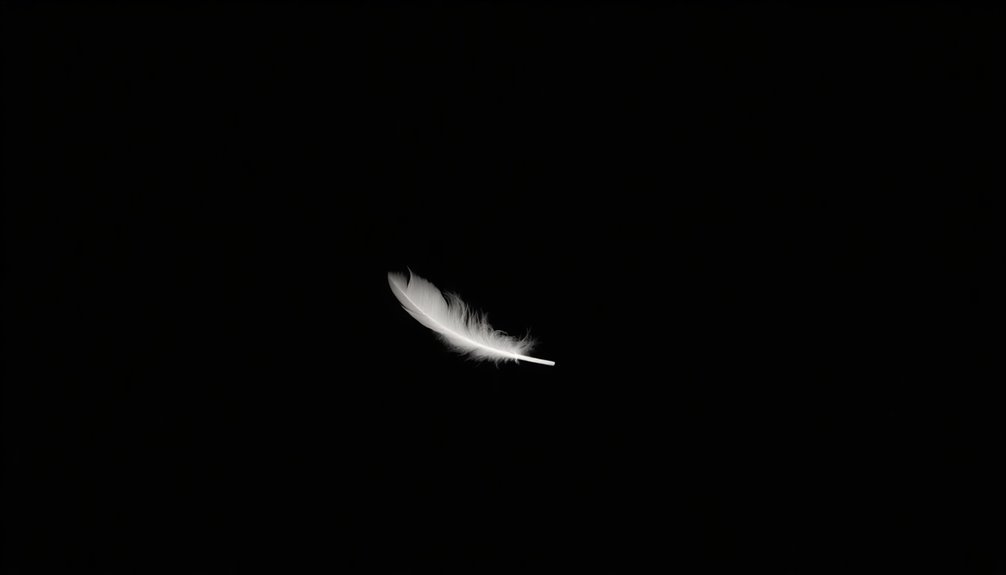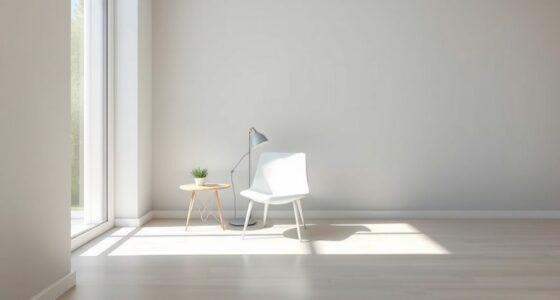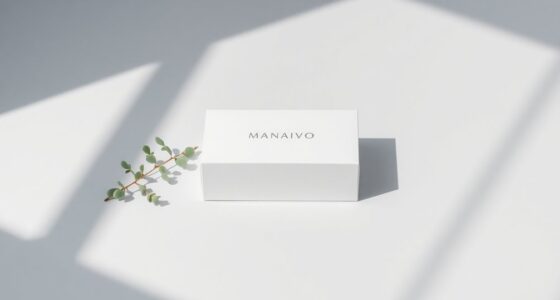Negative space is a enchanting element in art and design that highlights the beauty of absence. It draws your eye to the interaction between filled and empty spaces, shaping visual narratives. Designers like M.C. Escher and brands such as FedEx cleverly use negative space to create powerful imagery and messages. By appreciating these empty spaces, you can spark creativity and enhance clarity. There's so much more to explore about how negative space can inspire you and elevate your work.
Key Takeaways
- Negative space art emphasizes the importance of absence, enhancing composition and visual appeal through the interplay of positive and negative elements.
- Designers utilize negative space creatively, as seen in logos like FedEx and Panda Express, to convey messages with simplicity and impact.
- Techniques such as contrasting colors and distinct shapes can effectively highlight negative space, enriching artistic narratives and visual communication.
- Engaging with negative space fosters mindfulness, leading to improved well-being and enhanced creativity in both personal and professional contexts.
- Recognizing and embracing negative space cultivates resilience and adaptability, promoting a proactive approach to managing stress and challenges in life.
Understanding Negative Space Art

Negative space art reveals the hidden power of what's not there. It emphasizes the empty spaces surrounding your subject, greatly influencing the composition and overall aesthetic.
Negative space art highlights the significance of absence, shaping composition and enhancing visual appeal in unique ways.
When you explore negative space, you start to see how positive and negative elements interact. A prime example is Rubin's Vase, where the absence of form creates distinct shapes, showcasing this relationship.
Artists like M.C. Escher brilliantly use negative space to craft optical illusions and complex narratives.
In design, understanding and utilizing negative space is vital for enhancing visual impact, as seen in logos like FedEx, where the arrow formed by negative space symbolizes speed and direction. Creating an Interior Design Mood Board effectively showcases how this principle can be applied in interior design.
Engaging with negative space art opens your eyes to new dimensions of creativity.
The Historical Context of Negative Space

Throughout history, artists have recognized the power of empty space in their work, often using it to enhance their compositions. The concept of negative space has evolved considerably, influencing various artistic movements. Here are some key developments:
- Early Cave Paintings: Artists showcased awareness of negative space surrounding subjects, setting a foundation for future works.
- Gestalt Psychology: In the 20th century, this movement emphasized perception, illustrating how negative space interacts with positive space.
- M.C. Escher: He masterfully used negative space for optical illusions, remarkably in his lithograph "Relativity."
- Graphic Design Evolution: Designers increasingly harnessed negative space, effectively conveying complex messages and enhancing visual impact.
In contemporary art, the integration of AI-driven design has further pushed the boundaries of how negative space can be utilized, creating dynamic interactions between the viewer and the artwork.
Embracing negative space has led to innovative artistic expressions that challenge viewers' perceptions and deepen their engagement.
Applications of Negative Space in Design
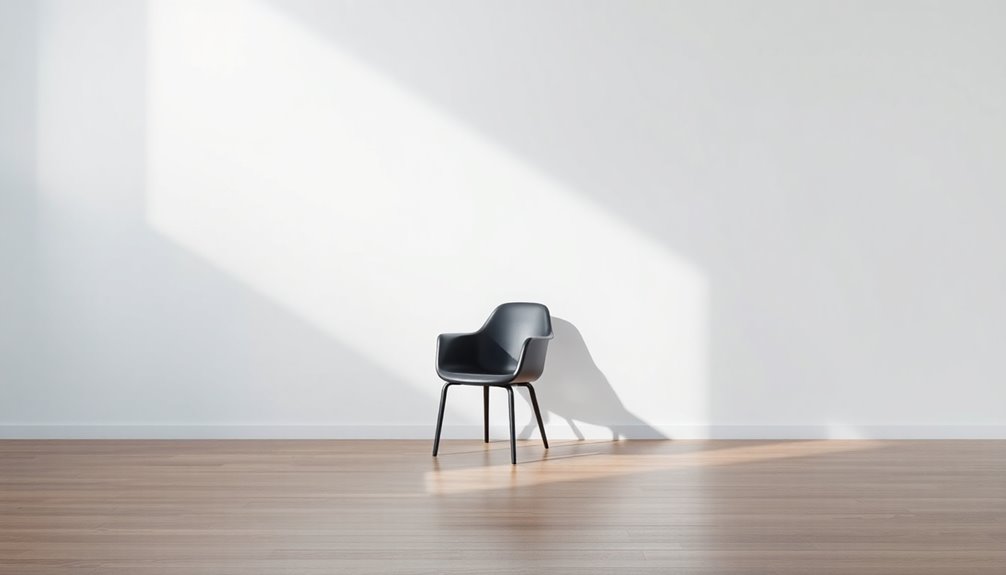
Artists have long understood the impact of negative space, and today, designers leverage this concept to create striking visual communications. The power of negative space allows for clever designs that communicate brand identity effectively.
Take the FedEx logo, for example, where a hidden arrow within negative spaces symbolizes speed and direction. Similarly, the Panda Express logo uses negative space to form a panda bear, showcasing simplicity in branding.
In typography, the Formula 1 logo cleverly incorporates the number "1" between letters, emphasizing speed. Advertising campaigns, such as SANCCOB, use negative space to highlight critical messages about wildlife.
Even everyday products like the Air Max 2017 engage consumers by using negative space to reflect lifestyle qualities, enhancing marketing impact. This clever use of design principles can be seen as a reflection of the strong brand identity that correlates with customer loyalty.
Techniques for Utilizing Negative Space

When you want to make the most of negative space in your designs, understanding a few key techniques can greatly enhance your compositions.
Here are some effective methods:
- Use Contrasting Colors: Differentiate between positive and negative spaces to enhance clarity and focus.
- Experiment with Compositions: Try various arrangements to find the best balance between positive and negative space.
- Incorporate Distinct Shapes: Use shapes that clearly define both positive and negative space, creating dynamic interactions.
- Utilize Cropping Techniques: Emphasize negative space to craft impactful visual narratives that draw attention to the main subject.
Additionally, consider how the principles of air quality improvement can inform your designs by creating a tranquil environment that complements the aesthetic of your work.
Negative Space in Various Art Forms
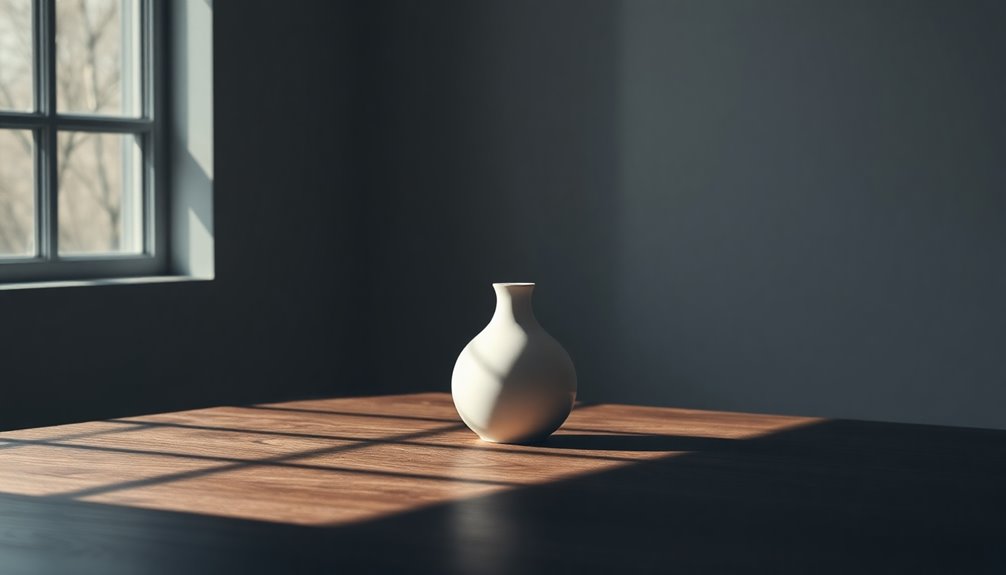
Negative space isn't just a technique; it's an essential element across various art forms.
In printmaking, it helps create depth, while in photography, it isolates subjects to enhance their impact.
Architecture also embraces negative space, using open areas to enrich the experience of a space. Additionally, high contrast ratios in design can dramatically influence how negative space is perceived, enhancing the overall visual appeal.
Printmaking Techniques Explored
Printmaking techniques offer a fascinating exploration of negative space, inviting you to see how absence can shape presence in art.
As a graphic artist, you can harness this powerful element to enhance your work in several ways:
- Linocut and Woodcut: These techniques carve out shapes, creating striking contrasts that highlight negative space.
- Layering: Experimenting with colors and textures allows you to manipulate negative space, adding depth to your compositions.
- Optical Illusions: Inspired by artists like M.C. Escher, you can use negative space to create intricate designs that challenge perceptions.
- Emotional Resonance: By balancing absence and presence, you can guide viewers' emotions and experiences, making your prints more impactful.
Additionally, engaging in internal company hackathons can provide fresh perspectives and collaborative opportunities to explore creative applications of negative space in your designs.
Embrace these techniques to elevate your art through the beauty of negative space.
Photography's Visual Isolation
In photography, the use of negative space plays an essential role in visual isolation, allowing you to draw attention to your subject while framing it within its environment.
By strategically incorporating negative space, you can highlight the positive space around the subject, enhancing its scale and context. This technique not only creates balance and harmony but also invites viewers to explore the relationship between the subject and its surroundings.
For example, renowned photographers like Ansel Adams effectively utilized negative space in landscapes, demonstrating that emptiness can be as powerful as the subject itself.
Through this approach, you can evoke emotions such as loneliness or tranquility, making your photographs resonate deeply with your audience. Additionally, the impact of sustainable materials in contemporary art practices reflects a broader understanding of how different elements interact to convey meaning.
Architecture's Open Spaces
While exploring the world of architecture, you'll notice how open spaces play a significant role in shaping our experience of built environments.
Architecture's open spaces, like courtyards and plazas, utilize negative space to enhance functionality and aesthetics. Here are a few ways negative space influences design:
- Natural Light: Open areas frame views and invite sunlight, creating warmth.
- Visual Balance: Thoughtful design balances built structures with surrounding space, enhancing beauty.
- Social Interaction: Public spaces encourage community engagement, essential for urban life.
- Tranquility: Architects like Tadao Ando evoke contemplation through intentional use of negative space.
In essence, space creates harmony between nature and architecture, enriching our daily experiences. Additionally, just as in campground amenities, the design of open spaces can greatly influence how people connect with their surroundings.
Embracing Negative Space in Everyday Life

Recognizing the importance of negative space in your daily life can lead to profound changes in your overall well-being. Embracing empty space allows you to value downtime, fostering mental clarity and reducing feelings of overwhelm.
By intentionally carving out moments for relaxation in your busy schedule, you create buffer zones that invite spontaneity and rejuvenation.
Mindfulness plays an essential role here—being aware of negative space in your environment, like decluttering, enhances focus and cultivates a peaceful atmosphere.
Moreover, acknowledging white spaces in conversations encourages pauses for reflection, transforming interactions.
Ultimately, embracing negative space opens doors to creativity and innovation, allowing fresh ideas to flourish and enriching your life with new perspectives. Additionally, developing resilience through these practices can significantly bolster your confidence in navigating life's challenges.
Frequently Asked Questions
What Is the Significance of Negative Space in Art?
Negative space plays an essential role in art by creating balance and highlighting the main subject.
When you effectively use negative space, you enhance the overall composition, making it more visually engaging. It can evoke emotions and set the tone, influencing how you connect with the piece.
What Famous Artists Use Negative Space?
Imagine flipping through a digital portfolio of renowned artists.
You'll find M.C. Escher, who masterfully plays with negative space in works like "Relativity."
Then, check out Noma Bar, whose illustrations cleverly use negative space for dual meanings.
Malika Favre's bold designs for "The Kama Sutra" stand out too.
Don't forget Rachel Whiteread, exploring absence in "Ghost," or the iconic FedEx logo, which hides an arrow in its negative space.
What Is the Use of Negative Space in Design?
Negative space in design plays a vital role in enhancing balance and focus. When you use it effectively, it guides your viewers' attention to the main subject while simplifying complex ideas.
It can evoke curiosity, making your designs more engaging. By creatively employing negative space, you not only improve visual communication but also strengthen your brand identity, allowing your audience to connect with the hidden elements of your work.
Which Element of Art Focuses on the Positive and Negative Space of a Work of Art?
The element of art that focuses on positive and negative space is composition.
When you arrange visual elements, you're balancing the main subject (positive space) with the surrounding area (negative space). This balance enhances the overall appeal and clarity of your artwork.
Conclusion
Incorporating negative space into your art and design is like finding hidden melodies in a symphony; it brings harmony and depth to your work. By understanding its power and applying the techniques we've discussed, you can transform your creative process. Embrace the beauty of what's not there, and let it inspire your everyday life. Remember, sometimes the most impactful elements lie in the spaces between, waiting for you to discover their potential.
